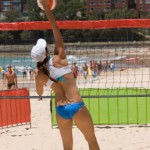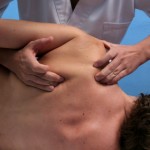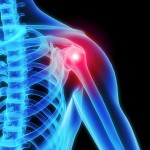Shoulder Pain
Do You Suffer From Shoulder Pain?
Shoulder pain is very common in many trades and professions in which there is any over head load on the body.

Take for example an electrician who may need to replace a ceiling light. He /she must reach overhead to hold the fixture in place with one hand while drilling a screw into the ceiling.
Shoulder pain is also very common with athletes involved in overhead throwing or hitting actions like a pitcher in baseball or spiker in volleyball.
Either way there is consistency in the overhead position of the arm in relation to the shoulder.
Keep in mind there are several types of shoulder injuries that lead to shoulder pain.
Shoulder Impairment

In this case the rotator cuff muscles have impingement due to a mechanical wear against the the acromiom in the suprahumeral space during elevation activities of the arm.
This shoulder impingement generally occurs for of two reasons:
1. Intrinsic Factors
2. Extrinsic Factors
Intrinsic Factors
Intrinsic factors may be vascular (poor circulation) changes in the rotator cuff, changes at the acromio-clavicular joint , changes to the coroco-acromial arch or the humeral head.
Unfortunately if this is the case , surgical intervention may be the only solution for the problem.
Extrinsic Factors
Extrinsic factors may be related to poor neuro-muscular control , coordination and faulty posture. This definitely can be treated.
Injuries associated with these extrinsic problems would include: supraspinatus tendonitis, infraspinatus tendonitis, bicipital tendonitis and tendonitis.
Signs and Symptoms of Shoulder Impingement
- painful arc – pain throug the middle range of raising your arm to the side
- poor posture
- -increased curves in the back
- muscle imbalance -tight or shortened pectoralis muscles , weak and or lengthened lateral rotator muscles of the shoulder and lengthened or weak mid fibres of trapezius and rhomboids as well as shortened or tight latissimus dorsi, subscapularis and subclavius -this is simialiar to the poor poture that leads to frozen shoulder.
Treatment for Shoulder Impingement
In most cases shoulder impingement syndromes can be treated with shoulder impingement exercises .
From a masage perspective , treating the following muscles to increase muscle length sense:
- pectoralis major
- pectoralis minor
- subscapularis
- teres major
- latissimus dorsi
- subclavius
You will notice that these are the same muscles treated with someone who has
frozen shoulder.

In most cases subclavius is a forgotten muscle . This muscle is responsible for allowing the shoulder to get past 150 degrees of abduction. If it remains shortened it will be difficult to regain full range of motion at the shoulder.
Joint play and scapular mobilization is also essential for complete range of motion.
Here is an example of myofascial release of the latissimus dorsi muscle for frozen shoulder but may also be used for shoulder impingment causingpain.
It is important to remebember that shoulder pain may be treated with massage but must also have
shoulder impingement exercises
to correct muscle imbalances to alleviate shoulder pain.

